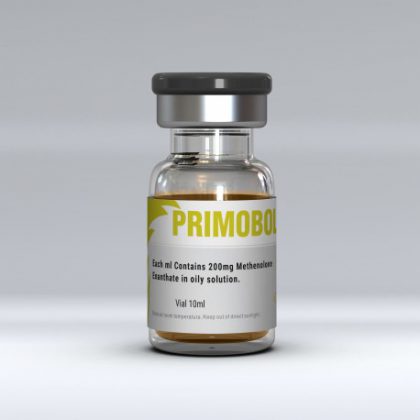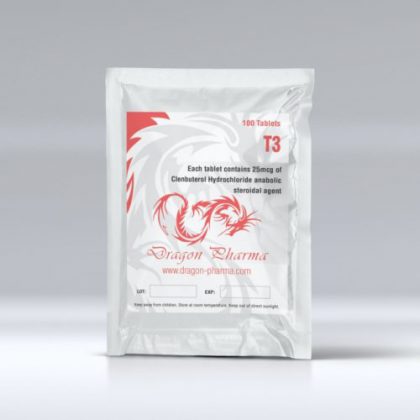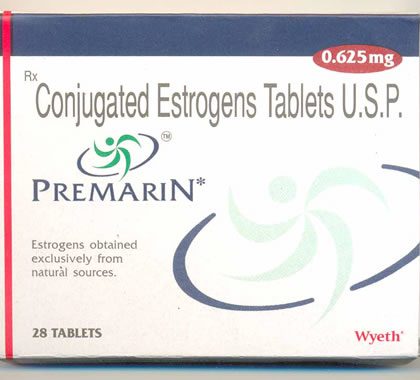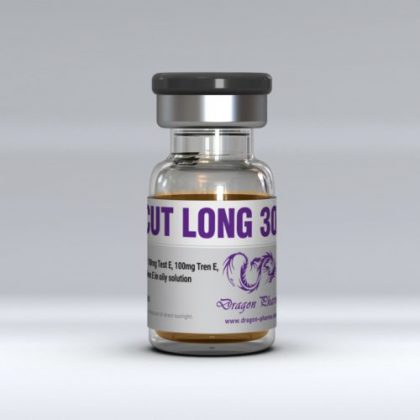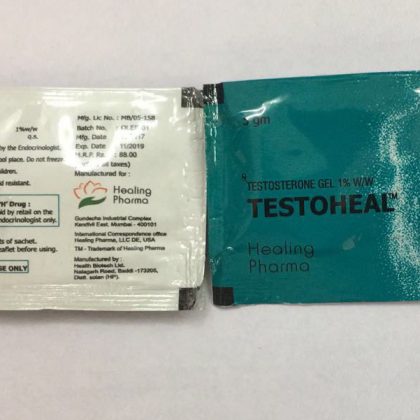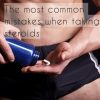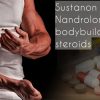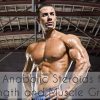- Carrello vuoto.
- Continua a fare acquisti
Steroidi anabolizzanti e androgeni

Questa classe di farmaci include sintetici derivati del testosterone - il principale ormone sessuale maschile che ha androgenic and anabolic effects. The proprietà androgeniche del testosterone nel corpo maschile determinano il sviluppo di caratteristiche sessuali secondarie: capelli sul corpo e viso, voce bassa, sviluppo ed erezione degli organi genitali, sessuali behavior, as well as aggressiveness. A manifestation of the anabolic qualities of testosterone is the acceleration of muscle growth.
For quite some time, doctors tried to use natural testosterone to treat diseases that cause weight loss. Unfortunately, testosterone in its natural form has a half-life in the body of only about ten minutes. This means that half the dose of testosterone is excreted 10 minutes after it was injected there. After that, every 10 minutes, half the remaining amount is displayed. An hour later, nothing remains of the initial quantity. Injection of natural testosterone into the muscle can stretch the time of complete decay to 10 hours and this is not enough to produce any effect. Chemists have been working on natural testosterone in order to create a drug that works like testosterone but lives in the body long enough to produce some kind of effect. As a result, testosterone derivatives such as 17-alpha-alkylate, 17-beta-ester and 1-methyl were obtained. All anabolic-androgenic steroids currently in use are variations of one of these three derivatives of the testosterone molecule. 17-alpha-alkylates and 1-methyl are taken orally, and 17-beta-esters are given as an injection.
Qual è la base per gli steroidi anabolizzanti?
The created preparations differ from the initial substance – testosterone – either by lowered androgenic function, or by even higher androgenicity and lowered anabolic activity, or by increased efficiency in relation to both qualities. This explains the difference in the action, effectiveness and side effects of existing AAS.
For a time, it was believed that anabolic and androgenic steroids are two different things, and therefore, it is allegedly possible to develop new types of steroids that will simply increase muscle mass without androgenic side effects. However, it turned out that the anabolic and androgenic effects are caused by the same drugs, but in different tissues. Thus, any steroids that increase muscle mass, and carry an androgenic effect.
Nevertheless, there is a division into predominantly anabolic and predominantly androgenic steroids. Testosterone is used as a parameter for determining a steroid as an anabolic or androgen. Steroidi in cui è l'effetto androgeno rispetto al testosterone ridotti sono definiti come "steroidi anabolizzanti" e quelli in cui il Le qualità androgeniche sono più elevate sono gli "steroidi androgeni".
Since both anabolics and androgens have a common ancestor – testosterone and have a similar mechanism of action on the body, in this book they are considered as a single class of drugs – anabolic-androgenic steroids (AAS).
It is not possible to consider all biochemical processes that occur in the body when taking AAS in the framework of this book. Let us dwell only on those that are most interesting for athletes and relate mainly to the effects of AAS on the muscle cell.
Gli steroidi vengono somministrati per via intramuscolare o assunti per via orale. Quando viene iniettata, la sostanza entra direttamente nel sangue, nel forma di una compressa passa attraverso il tratto gastrointestinale al fegato, dove si rompe completamente o parzialmente o entra the blood in its original state. The lo steroide assunto entra nel sangue sotto forma di numerose molecole di steroidi that travel through the bloodstream throughout the body. Each steroid molecule carries information that it must transmit to certain cells of the body. The cells intended for this have different types of receptors on their outer membrane. One of them is steroid receptors, which are found in large quantities in muscle cells. Steroid receptors and steroid molecules of the same size and shape. And approach each other, like a “key to the lock.” The steroid receptor accepts the steroid molecule, passing by all other types of molecules. The same thing happens with other types of receptors that do not perceive steroid molecules, because intended only for “their” molecules. Quando il recettore degli steroidi e la molecola degli steroidi sono combinati in un file complesso, la molecola è in grado di trasmettere informazioni al muscle cell. It should be noted that la maggior parte delle molecole di steroidi si trovano nel sangue in uno stato legato, formandosi composti con globulina legante gli ormoni sessuali: 98% dello steroide le molecole nel sangue sono in uno stato legato e solo l'1-2% è libero state. The latter relate specifically to steroid molecules capable of forming a steroid-receptor complex. Bound steroid molecules are a passive part, because in this state, the muscle cell will not perceive them. For the sake of accuracy I’ll say that this percentage fluctuates.
Il il complesso di recettori steroidei formato è diretto al nucleo della cellula, dove è attaccato a segmenti specifici su segmenti di DNA nucleico acids. Iln transcription follows, i.e. DNA is imprinted. Il resulting ribonucleic acid leaves the cell nucleus and in the il citoplasma è attaccato all'RNA che si trova qui, dove si trova la proteina synthesis is increased by translation. In combination with intense strength training, this leads to a transverse increase in muscle cells (muscle hypertrophy).
Enhanced protein synthesis is seen as the main effect of steroids on the muscle cell, while steroid molecules carry other important information for athletes. Many things speak in favor of the fact that steroids also have a strong anti-catabolic effect. Thanks to them, the percentage of protein that breaks down in the muscle cell is reduced. In addition, steroid molecules block cortisol receptors located on the muscle cell membrane. And the strong catabolic hormone cortisol produced by the body loses its activity.
Altri vantaggi degli steroidi
Another advantage of steroids is that they increase the synthesis of creatine phosphate (CF) in the muscle cell. CF plays a crucial role in the restoration of adenosine triphosphate (ATP).
ATP is the basis of all muscle movements, because is a combustible material necessary for the cell to do the job. ATP accumulates in the muscle cell and, if necessary, turns into adenosine diphosphate (ADP). This process releases energy that allows the muscle cell to work. For the reverse process of ADP in ATP, CF is also needed. The more it is, the faster this restoration is and the more ATP is at the disposal of the muscle cell. In practice, this means that the muscle becomes stronger, but no more. Those who have already tried the steroid Oxandrolone once know that this drug primarily affects muscle strength. The fact is that it causes increased synthesis of CF in the muscle cell.
Another factor that is useful for athletes is that steroids accumulate carbohydrates in the muscle cell in the form of glycogen. This process goes along with increased accumulation of fluid, which together with an increase in muscle volume entails an improvement in their endurance.
Gli steroidi riducono la produzione di insulina endogena, come
una cellula muscolare può assorbire i nutrienti (carboidrati sotto forma di
glicogeno e proteine sotto forma di amminoacidi) con la loro assunzione, meno
dependent on insulin. This gives athletes the opportunity to reduce the percentage of fat and improve muscle hardness, as
l'insulina insieme alla sua qualità come potente ormone anabolico converte
glucosio in glicerolo e, infine, in trigliceridi, che porta
to the growth of fat cells. Those who
hanno usato steroidi almeno una volta sappi che durante l'allenamento in
muscoli coinvolti c'è un "effetto pompa", che i professionisti chiamano
“steroid pump.” The fact is that steroids increase blood volume and the number of red blood cells in it. Muscles become more voluminous. Along with these benefits, increased blood flow to the muscle cell increases the delivery of nutrients to it. The increased supply of oxygen to the body associated with this phenomenon is often used by middle and short distance runners.
After the steroid-receptor complex has fulfilled its purpose in the
nucleus of the cell, the steroid molecule returns to the bloodstream
and, for some time, again becomes suitable for the function described
above, or turns into an inactive molecule and, ultimately, is excreted
dal corpo insieme all'urina.
Not all steroid molecules in the blood immediately bind to the globulin-binding sex hormones or are in a free, active state. Some of them are immediately used by the body in the process of metabolism and removed from it. Another part can be converted by the body into female sex hormones – estrogens. This phenomenon is called aromatization and at first glance seems to be unthinkable. Ma, se guardi la struttura dell'ormone sessuale maschile - il testosterone - e la femmina - l'estradiolo - più vicino, è sorprendente they are very similar. The body easily copes with the task of producing the necessary structural changes in the molecule through enzymes.
Alcune molecole di steroidi vengono convertite, come le parti esogene del testosterone, in diidrotestosterone (DHT). Ha una maggiore affinità chimica per i recettori delle cellule muscolari rispetto a il testosterone stesso, e quindi alcuni esperti lo credono il diidrotestosterone è un ormone più potente rispetto ad entrambi ormoni sessuali maschili e femminili, mentre ha anche un alto potenziale di legame in against receptors of the sebaceous glands and their hair follicles. Interestingly, DHT cannot be converted to estrogen.
Alla fine, tutte queste molecole dopo un po 'vengono escrete nelle urine. Dovrebbe essere affrontato anche il problema dell'efficacia degli steroidi.
Some AAS, being in the blood, have an increased ability to bind to the desired receptors. The fact is that they can be in free form longer, and therefore have great chances to meet target receptor zones. Such drugs as Deca, Dianabol, Cypionate, Sustanon-250 and Parabolan are highly capable of finding the necessary receptors in the body of a wide variety of users, as they have a larger percentage of free molecules than others.
With all this, much depends on the characteristics of the organism of a particular user. Some athletes have an extremely large number of free receptors, which in turn radically enhances the anabolic effect. Questo spiega il fatto che alcuni sollevatori di pesi, assumendo piccole dosi di steroidi, aumentano continuamente la loro efficacia. Tra gli atleti ci sono individui con un piccolo numero di recettori nelle cellule muscolari, in relazione a questo, solo l'AAS più potente lo farà be effective for them. Very often, these users take high doses from a mixture of different steroids without any visible effect.
Some athletes have active receptor sites in areas where they would rather not be. For example, for some users, certain drugs cause acne, while for others, the same drugs in the same doses do not cause any reaction of the body. This also explains the fact that in some athletes, even with high doses of testosterone, there is no increase in the mammary glands, and in other users, any steroids, even Bambini, cause gynecomastia. It can be assumed that some individuals have a very large number of estrogen receptors in their breast tissue, while others have a very small number. There is nothing to be done with your individual number of receptors and their preferred location – this is your genetic trait.
In addition to the genetic factor, the age-related activity of receptors seems to be an important point. There is evidence that receptors are most active in young people under the age of 20 years. Of course, this is a generalization, but such, at least, are the trends. Steroids at this age are better absorbed and give maximum results. Pertanto, i rappresentanti di questa fascia di età possono assumere piccole dosi su a periodo di tempo più lungo e ottenere migliori prestazioni rispetto ai vecchi persone.
Avere più o meno compreso il meccanismo d'azione di AAS, passiamo ora direttamente a la descrizione dei farmaci di questo gruppo.



